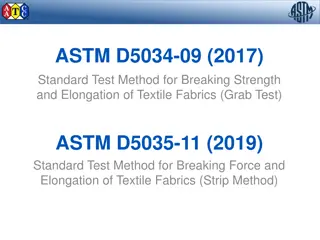Evolution of N-Rich Strip Adoption in N Management
The adoption of N-Rich Strip has transformed nitrogen management practices over the years. Starting from small applications in 2003 to widespread utilization across acres in Oklahoma and Kansas, the confidence in this approach has grown significantly. Farmers are advised to monitor N-rich strips and adjust nitrogen application based on visual cues to optimize yields. The emergence of the SBNRC model has further boosted confidence in the system, leading to improved nitrogen use efficiencies and yields. Additionally, market conditions and input costs have influenced the shift towards a three-pass system for optimal fertilization, especially during challenging periods like droughts. Case studies reveal increased grain yields, ranging from 50 to 90 bushels per acre, following the adoption of the N-Rich Strip and SBNRC.
Download Presentation

Please find below an Image/Link to download the presentation.
The content on the website is provided AS IS for your information and personal use only. It may not be sold, licensed, or shared on other websites without obtaining consent from the author.If you encounter any issues during the download, it is possible that the publisher has removed the file from their server.
You are allowed to download the files provided on this website for personal or commercial use, subject to the condition that they are used lawfully. All files are the property of their respective owners.
The content on the website is provided AS IS for your information and personal use only. It may not be sold, licensed, or shared on other websites without obtaining consent from the author.
E N D
Presentation Transcript
How the adoption of the N-Rich Strip has changed N Management Brian Arnall Precision Nutrient Management Oklahoma State University
N Rich Strip Adoption 2003: OSU applied 62 NRS 2004: 300 NRS in Farmers Fields 2005: SBNRC released, 1000 NRS 2006: OSU applied 568 NRS 1,500 ac NRS by 1 cooperator alone estimated 230,000 acres under NRS 2007: 25 county educators reported having NRS 2011: Estimated 500,000 acres utilizing NRS 2016: Best guess estimate 1.0+ million acres in OK & KS
Nitrogen Rich Strip Pamplet We commonly recommend that farmers apply of the anticipated total N needed at planting and wait to make the decision on added N until the middle of the season. In general for winter wheat, if no differences can be visually detected prior to jointing (Feekes 6, Figure 4), it is unlikely that added N will result in increased yields. Alternatively if differences are large, there is a high demand for added N. When no differences exist between the N Rich Strip and the farmer practice it means one of two things. Wait until early February or March to sense yield potential and apply top-dress N for winter wheat. Wait until the 8 or 10 leaf stage in corn to sense and apply fertilizer.
GDDs >0 the 80 Rule Brents Rules Apply 25 lbs N/ac at planting Place High N strips (~150lbs N/ac) in each field prior to emergence. Mark with a flag on one end and write down location info. Use handheld GreenSeeker unit to monitor NDVI as GDD s approach 80. Topdress as soon as GDD > 80. Hagie STS12 w/ 100 boom, UAN, streamer tips, FmX, RT-200 Record everything in a spreadsheet GreenSeeker log.xlsx
NRS and SBNRC Confidence After a decade + a confidence in the YP model and SBNRC reached. Annual reports of YP being within 5 bushel of combine records. Research plots documenting SBNRC resulting increased NUEs and Yields over time.
Market, Fert$, N-Rich Strips Grain only producers during drought 2012 + looked to reduce input risk. Grain prices of 2016 + is intensifying this. The current move is to a three pass system. Starter 45-70 lbs DAP Late fall early Spring Top-dress Jointing Top-dress They are only confident in this with use of N-Rich Strip
Case Studies Four Producers and one Consultant Been working closely with for past six plus years. After the 2017 harvest we have looked at inputs and yields. Grain yields running 50 to 90 bpa. Some farms averaging 65+ Since Adoption of SBNRC and 3 pass system Averaging 1.3-1.5 lbs N per bushel.
Our Challenge. The YP model and SBNRC built on a 50/50 N management system N recommendations being made near stem elongation 80+ GDDs>0 Because of the shift in management over the past three seasons more and more N-Rich Strips are showing up earlier. 35+ days, November- December.
Response at 39 GDDs > 0 300 250 Yield (bushel per acre) Yield 45 22 45 59 RI Harv 2.06 Pre plant Check 0 DAVD 49 DAVD 200 YP0 150 2.04 2.66 YPN 100 50 0 0 50 100 150 GDDs > 0 (From planting) 2.5 Best Prediction YP0 = 89 YPN = 81 YPNx = 67 RI = 96 2.0 RI Adjusted 1.5 1.0 0.5 0.0 0 50 100 150 GDDs > 0 (From Planting)
Response at 58 GDDs > 0 140 120 Yield (bushels per acre) YP0 100 Yield 57 37 71 83 RI Harv 1.56 YPN 80 PrePlant Check 0 DAVD 42 DAVD 60 1.92 2.26 40 20 0 40 60 80 100 120 GDDs > 0 (From planting) 2.0 Best Prediction YP0 = 80 YPN = 66 YPNx = 58 RI = 96 1.5 RI Adjusted 1.0 0.5 0.0 0 50 100 150 GDDs > 0 (From Planting)
Using An Agronomic Adjust Telling producers, plan on a March sensing/application if weather holds.
Brian Arnall 373 Ag Hall 405-744-1722 b.arnall@okstate.edu Presentation available @ www.npk.okstate.edu Twitter: @OSU_NPK www.Facebook/OSUNPK YouTube Channel: OSUNPK Blog: OSUNPK.com www.Aglandlease.info
Yield and Protein 70 16 70 20 N40 Perkins Feb 12 60 60 Feb 20 16 Yield Bushels per acre 12 Yield Busheld per acre 50 50 40 12 Protein 40 Protein 8 30 30 8 20 20 4 4 10 10 0 0 0 0 90 12 Mar 27 Mar 9 90 16 80 80 70 Yield Busheld per acre 70 Yield Busheld per acre 12 60 8 60 Protein 50 Protein 50 40 8 40 30 4 30 20 4 20 10 10 0 0 0 0
N timing Studies Looking at delaying of N app after N-Rich strip visual Diff One aspect, All 90 lbs N as NH4NO3, N-Rich ran out. Did this so we could evaluate timing of app in the study.























